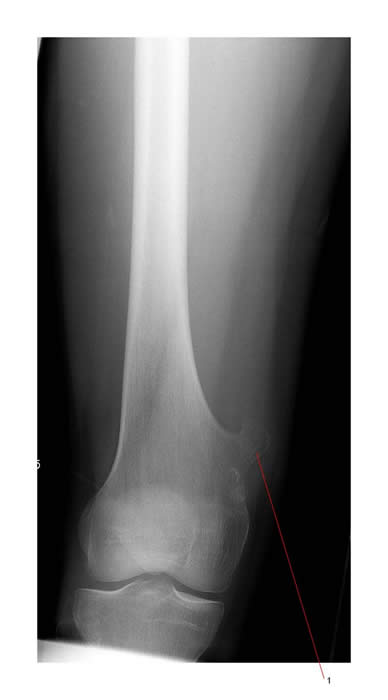Musculoskeletal
Osteochondroma
Osteochondromas
These tumors are secondary to abnormal endochondral bone growth, triggered by epiphysial injury.
Causes:
- Genetic
- Familial osteochondromas are often multiple
- Sporadic
- Sporadic osteochondromas are rare in the general population and account for only 1–2% of bone tumours
- Secondary to radiation therapy (RT):
- Osteochondromas develop more frequently in children whose epiphyses have been irradiated than in the general population.
Pathogenesis:
- Failure of differentiation of the reserve cell layer in the epiphysial growth zone
- Undifferentiated cartilage persists in the metaphysis where it may develop into an osteochondroma.
Radiation Therapy (RT)
- Causes sublethal damage, repair and regeneration
- Osteoblasts disappear and cartilage production at the epiphysial line decreases, often resulting in growth arrest.
- After growth processes are resumed they may be abnormal and start later
Chemotherapy and RT together can significantly arrest growth causing the epiphyses to remain open longer than usual and allowing osteochondromas more time to develop
Studies in the literature suggest an overall incidence of osteochondroma of 11–14% in children who receive RT.
Post-RT osteochondromas usually occur in or at the periphery of the RT field and do not differ histologically or in radiographic appearance from sporadic osteochondromas
Low dose whole body RT (TBI):
- Dose usually only 12 Gy
- Given prior to bone marrow transplant
- Incidence of osteochondroma is higher than in other pediatric cancer survivors
Young age increases risk: One study showed that patients who received TBI, 24% of those who survived greater than 30 months and who were under the age of 5 years at the time of treatment developed an osteochondroma. Patients between 5 years and 15 years did not develop osteochondromas
The lowest dose reported to produce an osteochondroma in a RT field was less than 1 Gy in an infant with non-malignant disease. There is no clear dose-response relationship
The commonest site for osteochondroma is the scapula.
The latent period after RT to development of osteochondroma is usually about 5 years (range between 2.5 to 10 years).
Below is a plain X-ray of a benign osteochondroma (#1) of the distal femur in a patient who had low dose whole body RT prior to bone marrow transplant.

Malignant transformation of solitary osteochondromas:
Very rare. Reported incidence less than 1% (In hereditary, multiple exostosis the incidence of malignant degeneration is higher at about 2.5%).
Any change in size or clinical symptoms should be investigated The presence of an enlarging mass or the onset of pain should arouse suspicion of possible malignant degeneration.
Screening for osteochondromas is controversial. Screening may provide more precise epidemiological data in an ever increasing population of long-term survivors, but a widespread screening programme would not be cost effective and the exposure to further radiation would be difficult to justify.

